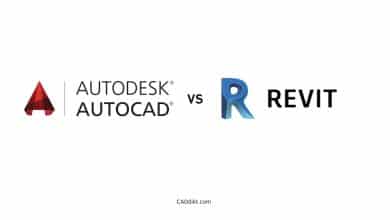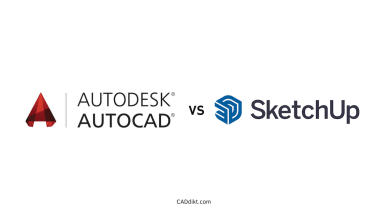In the realm of Computer-Aided Design (CAD), AutoCAD and Catia are two of the most widely used software, each with their unique strengths and capabilities. The choice between AutoCAD and Catia is a significant one that can impact productivity, cost, and the overall quality of work. This detailed comparison aims to provide a comprehensive understanding of these two powerful tools, enabling you to make an informed decision based on your specific needs.
The CAD industry is evolving at a rapid pace, with advancements in technology continually raising the bar for what these tools can achieve. Whether you’re an architect drafting 2D designs or an aerospace engineer working on complex 3D models, understanding the differences between AutoCAD and Catia is crucial to maximize efficiency and meet your design objectives.
Key Takeaways
- AutoCAD is renowned for its user-friendly interface and versatility, making it suitable for a wide range of industries. In contrast, Catia’s advanced features make it ideal for complex 3D designs, particularly in the automotive and aerospace industries.
- While AutoCAD offers more affordable pricing options, Catia’s cost is generally higher due to its advanced capabilities.
- AutoCAD’s compatibility and integration capabilities are extensive, while Catia offers seamless integration with other Dassault Systèmes software.
- Training and support resources for AutoCAD are more comprehensive compared to Catia, but both offer significant learning resources.
AutoCAD vs Catia: Setting the Scene
AutoCAD and Catia are two leading software applications in the Computer-Aided Design (CAD) industry. Both applications have their strengths and weaknesses, and your choice between them will depend on your specific needs and constraints. In this article, we will explore these two CAD tools in depth, from their features and capabilities to their industry applications, usability, cost, and more.
AutoCAD: A Brief Overview
AutoCAD, developed by Autodesk, is a versatile 2D and 3D CAD software widely used in several industries, such as architecture, engineering, and manufacturing. It’s particularly known for its intuitive interface, robust set of drafting and designing tools, and wide file compatibility.
Key Features of AutoCAD
- 2D Drafting and Annotation: AutoCAD provides a comprehensive set of tools for creating and editing 2D geometry.
- 3D Modeling and Visualization: AutoCAD allows users to create, render, and animate 3D models.
- Customization and Automation: Users can customize the software’s functionality using AutoLISP and other scripting languages.
- Wide File Compatibility: AutoCAD supports a broad range of file formats for import and export.
Catia: A Brief Overview
Catia, developed by Dassault Systèmes, is a powerful 3D CAD software that excels in complex, precision-oriented tasks. It’s commonly used in industries like automotive, aerospace, and industrial machinery, where high-level surface modeling and solid modeling are required.
Key Features of Catia
- 3D Part Design: Catia provides a rich set of tools for 3D part and assembly design.
- Surface Modeling: Catia excels in high-quality surface modeling, particularly useful in the automotive and aerospace industries.
- Product Lifecycle Management (PLM): Catia integrates with Dassault Systèmes’ ENOVIA, providing comprehensive PLM capabilities.
- Systems Engineering: Catia enables the design and management of complex systems, integrating multiple disciplines.
Comparing AutoCAD and Catia
Now, let’s compare AutoCAD and Catia based on various factors.
| Features | AutoCAD | Catia |
|---|---|---|
| 2D Drafting | ✔️ | ✔️ |
| 3D Modeling | ✔️ | ✔️ |
| Surface Modeling | ✔️ | |
| Mechanical Engineering | ✔️ | ✔️ |
| Architecture | ✔️ | |
| PLM Integration | ✔️ | |
| Systems Engineering | ✔️ | |
| Customizability | ✔️ | ✔️ |
Use Cases: AutoCAD vs Catia
AutoCAD Use Cases
AutoCAD is an industry-standard for drafting and design in various fields. Its use cases include:
- Architectural Design: Drafting floor plans, sections, elevations, and other architectural drawings.
- Engineering: Creating mechanical parts, assemblies, and schematics.
- Civil Engineering: Designing infrastructure such as roads, bridges, and drainage systems.
- Interior Design: Crafting detailed interior designs and layouts.
Catia Use Cases
Catia is particularly favored in industries where complex, precision 3D models are needed. Its use cases include:
- Aerospace: Designing aircraft components and assemblies.
- Automotive: Crafting detailed car parts and full-body designs.
- Industrial Machinery: Developing complex machinery and equipment.
- Systems Engineering: Designing and managing complex systems like electrical circuits and HVAC systems.
User Experience: AutoCAD vs Catia
AutoCAD User Experience
AutoCAD is renowned for its user-friendly interface and easy learning curve, making it suitable for beginners and professionals alike. The software is compatible with both Windows and macOS, and Autodesk provides extensive learning resources, including tutorials and forums.
Catia User Experience
Catia’s user interface is more complex and can be challenging for new users. However, its advanced features provide unmatched capabilities for complex design tasks. Catia is only compatible with Windows, and though learning resources are available, they are less comprehensive compared to AutoCAD.
Pricing: AutoCAD vs Catia
AutoCAD Pricing
AutoCAD offers several subscription options:
- Monthly: $210
- 1 Year: $1,690
- 3 Years: $4,565
Catia Pricing
Catia doesn’t provide standardized pricing; it depends on the specific modules and configurations you need. Generally, it’s more expensive than AutoCAD.
Integration and Compatibility
AutoCAD Integration and Compatibility
AutoCAD has wide-ranging compatibility and integrates with several other Autodesk products, including Revit and Inventor. It supports a broad array of file formats like DWG, DXF, DWF, and more.
Catia Integration and Compatibility
Catia integrates seamlessly with other Dassault Systèmes software, such as ENOVIA for PLM and DELMIA for digital manufacturing. It supports various file formats, including its native CATPart and CATProduct, as well as STEP, IGES, and more.
AutoCAD vs Catia: Strengths and Limitations
AutoCAD Strengths and Limitations
Strengths
- Easy to learn and use
- Wide range of capabilities
- Extensive support and learning resources
- Affordable subscription options
Limitations
- Less suited for complex 3D designs
- Limited capabilities for PLM
Catia Strengths and Limitations
Strengths
- Excellent for complex 3D designs
- PLM integration
- Advanced systems engineering capabilities
Limitations
- Steep learning curve
- High cost
Which One Should You Choose: AutoCAD or Catia?
Your choice between AutoCAD and Catia will depend on your specific needs. If you’re in an industry that requires detailed 2D drawings, architectural designs, or straightforward 3D modeling, AutoCAD might be a better choice due to its user-friendly interface, affordable cost, and extensive support resources.
However, if you’re dealing with complex 3D designs, particularly in industries like automotive or aerospace, or you need advanced PLM capabilities, Catia may be worth the investment. Remember, the best software is the one that fits your specific needs and constraints.
The Verdict: AutoCAD vs Catia
Both AutoCAD and Catia have their respective strengths that make them suited to different industries and use cases. For instance, architects, civil engineers, and entry-level CAD users might prefer AutoCAD for its simplicity and cost-effectiveness. On the other hand, mechanical engineers, product designers, and professionals in the automotive and aerospace industries might lean towards Catia for its advanced 3D design and PLM capabilities.
Training and Support
When considering a CAD software, you should also think about the availability and quality of training and support resources.
AutoCAD Training and Support
Autodesk offers a wealth of resources for AutoCAD users, including an extensive knowledge base, tutorials, forums, and direct support. They also offer Autodesk University, an online learning platform with courses on various Autodesk software.
Catia Training and Support
Dassault Systèmes provides support for Catia users, though it’s generally considered less comprehensive than AutoCAD’s. There are also fewer community resources for Catia, which can make the learning process more challenging.
The Future of CAD: AutoCAD vs Catia
Looking towards the future, both AutoCAD and Catia are continually evolving and adding new features to meet the changing needs of the CAD industry.
AutoCAD’s Future
AutoCAD’s recent updates have focused on improving 3D modeling capabilities, enhancing performance, and better integrating with other Autodesk products. They’ve also invested in cloud-based technologies, with the launch of AutoCAD Web and AutoCAD Mobile.
Catia’s Future
Catia has been expanding its capabilities in areas like additive manufacturing, cloud-based solutions, and real-time collaboration. They’re also investing in technologies like virtual reality (VR) and artificial intelligence (AI) to enhance the design process.
Frequently Asked Questions
1. Can AutoCAD and Catia Files Be Interchanged?
Yes, it is possible to interchange files between AutoCAD and Catia, although the process may not always be straightforward. AutoCAD primarily uses the DWG file format, while Catia uses CATPart and CATProduct. To exchange files between these two CAD programs, you will typically have to use a neutral file format, such as STEP or IGES, that both programs can read and write. However, when translating files between different formats, some data loss may occur, particularly for complex 3D models or detailed attributes.
Furthermore, it’s important to bear in mind that while the geometry may transfer well, other characteristics of the design, such as constraints, parametric features, or assembly relations, may not. This is due to differences in the way these CAD systems handle and store this information. Therefore, when transferring files between AutoCAD and Catia, it’s crucial to check the integrity of the design after import.
2. How Does AutoCAD and Catia Perform on Different Operating Systems?
AutoCAD is versatile and performs well on both Windows and macOS. It provides nearly identical features on both operating systems, which allows a smooth transition between the two. The interface and commands are also similar, ensuring that users can switch between different platforms without a steep learning curve.
On the other hand, Catia is exclusively available for Windows, which can be a limiting factor for users who prefer or need to use other operating systems. In case you are required to use Catia on a non-Windows operating system, you might need to use virtualization software, which can impact performance. Catia is also available on Unix, but that version is typically used in more specialized or legacy environments and may not have all the latest features available in the Windows version.
3. Is It Possible to Use AutoCAD and Catia Simultaneously on a Project?
Yes, it’s possible to use both AutoCAD and Catia on a single project, and it’s not uncommon for larger companies to use multiple CAD systems. For instance, you might use AutoCAD for 2D drafting and basic 3D modeling and then switch to Catia for advanced 3D design or PLM tasks.
However, using multiple CAD systems on a single project can introduce complications. As mentioned earlier, exchanging files between different CAD systems can result in data loss or require additional work to ensure the integrity of the design. Also, managing licenses, training, and support for multiple CAD systems can add to the complexity and cost.
4. How Frequently Are AutoCAD and Catia Updated?
Both AutoCAD and Catia have annual release cycles where they introduce new features and enhancements. Autodesk typically releases new versions of AutoCAD in March, while Dassault Systèmes usually releases new versions of Catia in the second quarter of the year.
In addition to these major releases, both vendors also provide periodic updates throughout the year to fix bugs, improve performance, and occasionally add new features. These updates are usually available to all users with an active subscription or maintenance plan. It’s recommended to keep your software updated to take advantage of the latest enhancements and ensure optimal performance and stability.
5. What Kind of Support Is Available for AutoCAD and Catia?
Both Autodesk and Dassault Systèmes offer various support options for their respective CAD software. For AutoCAD, Autodesk provides direct support via phone, chat, or email. They also offer a comprehensive online knowledge base, user forums, and learning resources.
For Catia, Dassault Systèmes also provides direct support, although the availability may depend on the specific support plan you have. They also offer an online knowledge base and user forums, but these resources are generally considered less comprehensive than Autodesk’s. However, both vendors also have a network of resellers and partners who can provide additional training and support services.
6. Can I Customize AutoCAD and Catia to Suit My Specific Needs?
Yes, both AutoCAD and Catia offer extensive customization capabilities. In AutoCAD, you can customize the user interface, create custom commands and macros, and even develop custom applications using AutoLISP or .NET. Autodesk also provides a robust API (Application Programming Interface) that developers can use to extend the software’s functionality or integrate it with other systems.
Similarly, Catia also offers a customizable user interface and supports macros for automating repetitive tasks. For more advanced customization, Catia provides a comprehensive API that can be used with C++, VBScript, or other programming languages. Catia’s API is particularly powerful and allows developers to create sophisticated applications or customizations that can dramatically enhance the software’s capabilities.
7. Are There Any Alternatives to AutoCAD and Catia?
Yes, there are many alternatives to both AutoCAD and Catia. For 2D drafting and basic 3D modeling, alternatives to AutoCAD include DraftSight, MicroStation, and BricsCAD. These programs offer similar functionality to AutoCAD and can often read and write DWG files.
For advanced 3D design and PLM, alternatives to Catia include Siemens NX, PTC Creo, and SOLIDWORKS. These programs offer robust 3D modeling capabilities, and some also provide integrated PLM solutions. However, like Catia, these are high-end CAD systems and can be quite expensive.
Ultimately, the best alternative will depend on your specific needs, budget, and the industry you’re working in. It’s recommended to evaluate multiple options and consider factors such as features, usability, support, and integration with other systems before making a decision.
Final Thoughts
Both AutoCAD and Catia stand as powerful contenders in the CAD software market, each offering unique capabilities to meet the diverse needs of designers across industries. The choice between the two ultimately depends on the specific design requirements, budget constraints, and the industry at hand.
By understanding the strengths and limitations of each software, you can leverage their capabilities to drive productivity and innovation in your design process. Whether you choose AutoCAD for its simplicity and cost-effectiveness or Catia for its advanced 3D design and PLM capabilities, both tools have the potential to significantly enhance your design workflow when utilized effectively.








